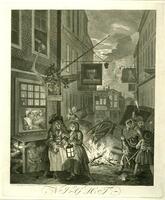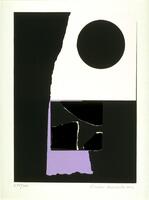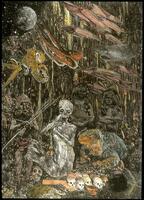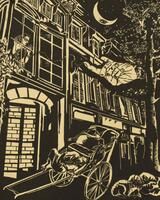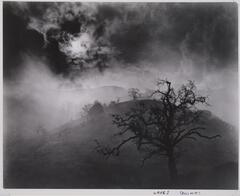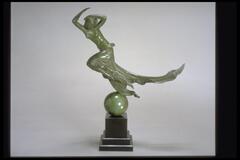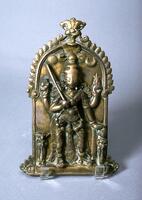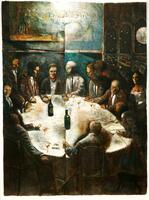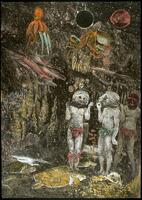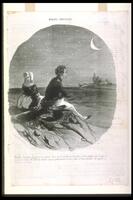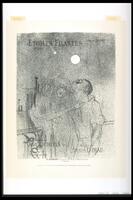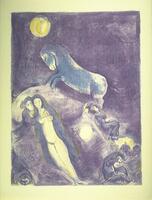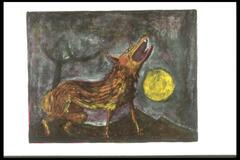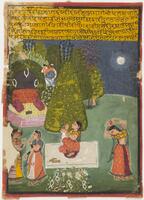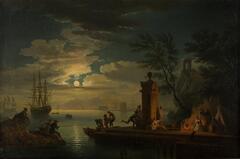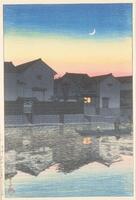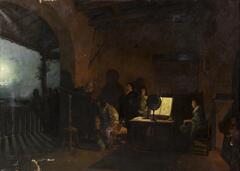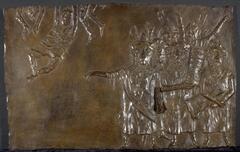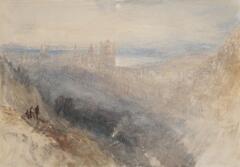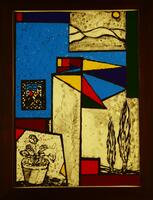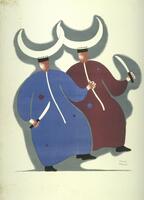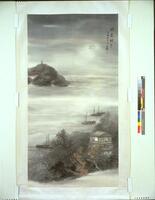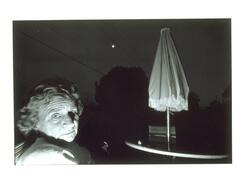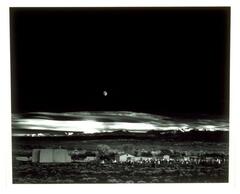The Moon has been looming overtop of humans since before recorded history. The silent counterpart to the mighty sun, the moon is ever present in our eyes, our minds, and in our imagination. The way the moon has been weaved into different mythologies, religions, traditions, and cultures from all around the world is astounding but also not surprising, as the moon is something we all experience. This introspective look at artworks featuring the Moon strives to make comparisons between works that span centuries and many different style and mediums, all of whom share the same goal of depicting something we see every night, the Moon.
33 Items in this Learning Collection
Collection Object
Collection Object
Collection Object
Collection Object
Collection Object
Collection Object
Collection Object
Collection Object
Collection Object
Collection Object
Collection Object
Collection Object
Collection Object
Collection Object
Collection Object
Collection Object
Collection Object
Collection Object
Collection Object
Collection Object
Collection Object
Collection Object
Collection Object
Collection Object
Collection Object
Collection Object
Collection Object
Collection Object
Copyright
All Rights Reserved
()
Evening Scene in Tokyo: Bon Dance
Accession Number
1991/2.113
Title
Evening Scene in Tokyo: Bon Dance
Artist(s)
Takahashi Hiroaki
Object Creation Date
circa 1900-1921
Medium & Support
color woodblock print on paper
Dimensions
15 in. x 6 11/16 in. ( 38.1 cm x 17 cm )
Credit Line
Gift of Millard Pryor in Memory of Mary S. Pryor
Label copy
Kawase Hasui and Takahashi Hiroaki both worked in concert with the prolific twentieth century publisher of woodblock prints Watanabe Shôzaburô (1885-1962). Their poetic and often times nostalgic landscape prints, very much following Edo period print master Andô Hiroshige’s foot prints (whose works are also shown in the gallery), have been highly sought after by collectors in Europe and North America.
Kawase Hasui was especially known for his skillful depiction of landscapes and night scenes. His passion for landscapes led him to travel extensively throughout Japan, keeping a sensitive eye on his surroundings and sketching scenes from his journeys. His close attention to atmospheric conditions and light brought him much success and one year before his death Kawase was awarded the great honor of Living Cultural Treasure for his 1956 print “Snow at Zôjôji Temple.”
Takahashi was trained in Japanese style painting (Nihonga), and dedicated much of his time to creating paintings for exhibitions as well as illustrations for scientific publications. While Kawase’s prints focus on notable places and landscapes, Takahashi’s work attempts to capture the essence of Japanese culture and everyday life.
(Japanese Gallery Rotation, Spring 2010)
(6/28/10)
*Gallery Rotation Winter 2011 (January 2011)
Takahashi Hiroaki
Japan, 1871–1944
Bon Dance, from the series Evening Scene in Tokyo
circa 1900–21
Meiji Period (1868–1912) to Taisho Period (1912–26)
Color woodblock print on paper
Gift of Millard Pryor in Memory of Mary S. Pryor, 1991/2.113
Subject matter
Takahashi Hiroaki worked with the prolific twentieth century publisher of woodblock prints Watanabe Shozaburo (1885-1962). Takahashi was trained in Nihonga, or Japanese painting, and dedicated much of his time to paintings for exhibitions and illustrations for scientific publications. His nostalgic “Old Japan” imagery was highly sought after by collectors in Europe and North America. Takahashi’s work attempts to capture the essence of cultural events and everyday life. The people in this print are doing a special dance for the summer bon festival, a festival of the dead.
Physical Description
A circle of festival-goers dances under a full moon. They only appear in silhouette, but the shapes of their kimono and fans in hand can be seen.
Primary Object Classification
Print
Primary Object Type
color print
Collection Area
Asian
Rights
If you are interested in using an image for a publication, please visit http://umma.umich.edu/request-image for more information and to fill out the online Image Rights and Reproductions Request Form.
Keywords
Ukiyo-e
dance (discipline)
festivals
moons
night
1991/2.113
Title
Evening Scene in Tokyo: Bon Dance
Artist(s)
Takahashi Hiroaki
Object Creation Date
circa 1900-1921
Medium & Support
color woodblock print on paper
Dimensions
15 in. x 6 11/16 in. ( 38.1 cm x 17 cm )
Credit Line
Gift of Millard Pryor in Memory of Mary S. Pryor
Label copy
Kawase Hasui and Takahashi Hiroaki both worked in concert with the prolific twentieth century publisher of woodblock prints Watanabe Shôzaburô (1885-1962). Their poetic and often times nostalgic landscape prints, very much following Edo period print master Andô Hiroshige’s foot prints (whose works are also shown in the gallery), have been highly sought after by collectors in Europe and North America.
Kawase Hasui was especially known for his skillful depiction of landscapes and night scenes. His passion for landscapes led him to travel extensively throughout Japan, keeping a sensitive eye on his surroundings and sketching scenes from his journeys. His close attention to atmospheric conditions and light brought him much success and one year before his death Kawase was awarded the great honor of Living Cultural Treasure for his 1956 print “Snow at Zôjôji Temple.”
Takahashi was trained in Japanese style painting (Nihonga), and dedicated much of his time to creating paintings for exhibitions as well as illustrations for scientific publications. While Kawase’s prints focus on notable places and landscapes, Takahashi’s work attempts to capture the essence of Japanese culture and everyday life.
(Japanese Gallery Rotation, Spring 2010)
(6/28/10)
*Gallery Rotation Winter 2011 (January 2011)
Takahashi Hiroaki
Japan, 1871–1944
Bon Dance, from the series Evening Scene in Tokyo
circa 1900–21
Meiji Period (1868–1912) to Taisho Period (1912–26)
Color woodblock print on paper
Gift of Millard Pryor in Memory of Mary S. Pryor, 1991/2.113
Subject matter
Takahashi Hiroaki worked with the prolific twentieth century publisher of woodblock prints Watanabe Shozaburo (1885-1962). Takahashi was trained in Nihonga, or Japanese painting, and dedicated much of his time to paintings for exhibitions and illustrations for scientific publications. His nostalgic “Old Japan” imagery was highly sought after by collectors in Europe and North America. Takahashi’s work attempts to capture the essence of cultural events and everyday life. The people in this print are doing a special dance for the summer bon festival, a festival of the dead.
Physical Description
A circle of festival-goers dances under a full moon. They only appear in silhouette, but the shapes of their kimono and fans in hand can be seen.
Primary Object Classification
Primary Object Type
color print
Collection Area
Asian
Rights
If you are interested in using an image for a publication, please visit http://umma.umich.edu/request-image for more information and to fill out the online Image Rights and Reproductions Request Form.
Keywords
Ukiyo-e
dance (discipline)
festivals
moons
night
